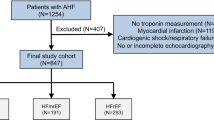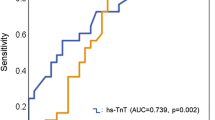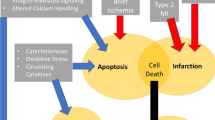Abstract
Troponin elevation correlates with an increased short and long-term mortality in patients with acute decompensated heart failure (AHF). However, it has not been included in the development of multiple validated predictive models of mortality. We aim to determine whether the addition of high-sensitivity troponin T (hs-TnT) to clinical risk scores improves the prediction of in-hospital mortality in patients with AHF. A retrospective analysis of a prospective and consecutive cohort was performed. Adult patients hospitalized between 2015 and 2019 with a primary diagnosis of AHF were included. Hs-TnT was measured on admission. OPTIMIZE-HF, GWTG-HF, and ADHERE risks score were calculated for each patient. The primary endpoint was all-cause in-hospital mortality. Discrimination of isolated hs-TnT and the risk scores with and without the addition of hs-TnT were evaluated using the area under the ROC curve (AUC-ROC). A subanalysis was performed according to left ventricular ejection fraction (LVEF). Of 712 patients, 562 (79%) had hs-TnT measurement upon admission, and was elevated in 91%. In-hospital mortality was 8.7% (n = 49). The AUC-ROC was 0.70 (95% CI 0.63–0.77) for isolated hs-TnT, and 0.80 (0.74–0.87), 0.79 (0.72 -0.86) and 0.79 (0.71–0.86) for the OPTIMIZE-HF, GWTG-HF and ADHERE scores, respectively. The addition of hs-TnT to the models did not increase the AUC: 0.72 (0.66–0.79) for the OPTIMIZE-HF + hs-TnT score (difference between AUC − 0.08 p = 0.04), 0.74 (0.68–0.80) for GWTG-HF (difference between AUC-0.04, p = 0.2) and 0.7 (0.63–0.77) for ADHERE (difference between AUC − 0.085 p = 0.07). The models presented good calibration (p > 0.05). In the sub-analysis, no differences were found between risk scores with the addition of hs-TnT in the population with LVEF < 40% and ≥ 40%. Elevated hs-TnT on admission was frequent and its incorporation into the validated risk scores did not prove an incremental prognostic benefit in patients hospitalized for AHF, regardless of LVEF. Isolated hs-TnT had a modest ability to predict hospital mortality. Additional prospective studies are needed to validate these findings.



Similar content being viewed by others
References
Bui AL, Horwich TB (2011) Fonarow GC (2011) Epidemiology and risk profile of heart failure. Nat Rev Cardiol 8:30–41
Metra M, Teerlink JR (2017) Heart failure. Lancet 390:1981–1995
Ketchum ES, Levy WC (2011) Establishing prognosis in heart failure: a multimarker approach. Prog Cardiovasc Dis 54:86–96
Allen LA, Stevenson LW, Grady KL, Goldstein NE, Matlock DD, Arnold RM, Cook NR, Felker GM, Francis GS, Hauptman PJ, Havranek EP, Krumholz HM, Mancini D, Riegel B, Spertus JA , American Heart Association; Council on Quality of Care and Outcomes Research; Council on Cardiovascular Nursing; Council on Clinical Cardiology; Council on Cardiovascular Radiology and Intervention; Council on Cardiovascular Surgery and Anesthesia. (2012). Decision making in advanced heart failure: a scientific statement from the American Heart Association. Circulation 125(1928):1952
Passantino A, Monitillo F, Iacoviello M, Scrutinio D (2015) Predicting mortality in patients with acute heart failure: Role of risk scores. World J Cardiol 7:902–911
Felker GM, Mentz RJ, Teerlink JR, Voors AA, Pang PS, Ponikowski P, Greenberg BH, Filippatos G, Davison BA, Cotter G, Prescott MF, Hua TA, Lopez-Pintado S, Severin T, Metra M (2015) Serial high sensitivity cardiac troponin T measurement in acute heart failure: insights from the RELAX-AHF study. Eur J Heart Fail 17:1262–1270
You JJ, Austin PC, Alter DA, Ko DT, Tu JV (2007) Relation between cardiac troponin I and mortality in acute decompensated heart failure. Am Heart J 153:462–470
Diez M, Talavera ML, Conde DG, Campos R, Acosta A, Trivi MS (2016) High-sensitivity troponin is associated with high risk clinical profile and outcome in acute heart failure. Cardiol J. 23(78):83
Fonarow GC, Peacock WF, Horwich TB, Phillips CO, Givertz MM, Lopatin M, Lopatin M, Wynne J (2008) Usefulness of B-type natriuretic peptide and cardiac troponin levels to predict in-hospital mortality from ADHERE. Am J Cardiol 101:231–237
Ilva T, Lassus J, Siirila-Waris K, Melin J, Peuhkurinen K, Pulkki K, Nieminen MS, Mustonen H, Porela P, Harjola VP (2008) Clinical significance of cardiac troponins I and T in acute heart failure. Eur J Heart Fail 10:772–779
Peacock WF 4th, De Marco T, Fonarow GC, Diercks D, Wynne J, Apple FS, Apple FS, Wu HB (2008) Cardiac troponin and outcome in acute heart failure. N Engl J Med 358:2117–2126
Abraham WT, Fonarow GC, Albert NM, Stough WG, Gheorghiade M, Greenberg BH, O’Connor CM, Sun JL, Yancy CW, Young JB (2008) Predictors of in-hospital mortality in patients hospitalized for heart failure: insights from the Organized Program to Initiate Lifesaving Treatment in Hospitalized Patients with Heart Failure (OPTIMIZE-HF). J Am Coll Cardiol. 52:347–356
Al-Saleh A, Alazzoni A, Al Shalash S, Ye C, Mbuagbaw L, Thabane L, Jolly SS (2014) Performance of the high-sensitivity troponin assay in diagnosing acute myocardial infarction: systematic review and meta-analysis. CMAJ Open 2:E199-207
Velilla Moliner J, Gros Bañeres B, Povar Marco J, Santaló Bel M, Ordoñez Llanos J, Martín Martín A, Ruize FT (2020) Diagnostic performance of high sensitive troponin in non-ST elevation acute coronary syndrome. Med Intensiva 44:88–95
Fitzgerald RL, Hollander JE, Peacock WF, Limkakeng AT, Breitenbeck N, Blechschmidt K, Laimighofer M, DeFilippi C (2019) Analytical performance evaluation of the Elecsys® Troponin T Gen 5 STAT assay. Clin Chim Acta 495:522–528
Parissis JT, Papadakis J, Kadoglou NP, Varounis C, Psarogiannakopoulos P, Rafouli-Stergiou P, Ikonomidis I, Paraskevaidis I, Dimopoulou I, Zerva A, Dima K, Anastasiou-Nana M, Filippatos G (2013) Prognostic value of high sensitivity troponin T in patients with acutely decompensated heart failure and non-detectable conventional troponin T levels. Int J Cardiol 168:3609–3612
Yancy CW, Jessup M, Bozkurt B, Butler J, Casey DE Jr, Drazner MH (2013) 2013 ACCF/AHA guideline for the management of heart failure: a report of the American College of Cardiology Foundation/American Heart Association Task Force on Practice Guidelines. J Am Coll Cardiol 62:e147-239
Fonarow GC, Adams KF Jr, Abraham WT, Yancy CW, Boscardin WJ, ADHERE Scientific Advisory Committee, Study Group, and Investigators (2005) Risk stratification for in-hospital mortality in acutely decompensated heart failure: classification and regression tree analysis. JAMA 293(572):580
Abraham WT, Fonarow GC, Albert NM, Stough WG, Gheorghiade M, Greenberg BH, O’Connor CM, Sun JL, Yancy CW, Young JB (2008) Predictors of in-hospital mortality in patients hospitalized for heart failure: insights from the Organized Program to Initiate Lifesaving Treatment in Hospitalized Patients with Heart Failure (OPTIMIZE-HF). J Am Coll Cardiol 52:347–356
Peterson PN, Rumsfeld JS, Liang L, Albert NM, Hernandez AF, Peterson ED, Fonarow GC, Masoudi FA (2010) A validated risk score for in-hospital mortality in patients with heart failure from the American Heart Association get with the guidelines program. Circ Cardiovasc Qual Outcomes 3:25–32
Giannitsis E, Kurz K, Hallermayer K, Jarausch J, Jaffe AS, Katus HA (2010) Analytical validation of a high-sensitivity cardiac troponin T assay. Clin Chem 56:254–261
Pencina MJ, D’Agostino RB Sr, D’Agostino RB Jr, Vasan RS (2008) Evaluating the added predictive ability of a new marker: from area under the ROC curve to reclassification and beyond. Stat Med 27:157–172
Pocock SJ, Ariti CA, McMurray JJV, Maggioni A, Køber L, Squire IB, Swedberg K, Dobson J, Poppe KK, Whalley GA, Doughty RN (2013) Predicting survival in heart failure: a risk score based on 39 372 patients from 30 studies. Eur Heart J 34:1404–1413
Rahimi K, Bennett D, Conrad N, Williams TM, Basu J, Dwight J, Woodward M, Patel A, McMurray J, MacMahon S (2014) Risk prediction in patients with heart failure. JACC Heart Fail 2:440–446
Ouwerkerk W, Voors AA, Zwinderman AH (2014) Factors influencing the predictive power of models for predicting mortality and/or heart-failure hospitalization in patients with heart failure. JACC Heart Fail 2:429–436
Lupón J, de Antonio M, Vila J, Peñafiel J, Galán A, Zamora E, Urrutia A, Bayes-Genis A (2014) Development of a novel heart failure risk tool: the Barcelona bio-heart failure risk calculator (BCN bio-HF calculator). PLoS ONE 9:e85466
Levy WC (2006) The Seattle Heart Failure Model: prediction of survival in heart failure. Circulation 113:1424–1433
Mozaffarian D, Anker SD, Anand I, Linker DT, Sullivan MD, Cleland JGF, Carson PE, Maggioni AP, Mann DL, Pitt B, Poole-Wilson PA, Levy WC (2007) Prediction of mode of death in heart failure: the Seattle Heart Failure Model. Circulation 116:392–398
Lee DS, Austin PC, Rouleau JL, Liu PP, Naimark D, Tu JV (2003) Predicting mortality among patients hospitalized for heart failure: derivation and validation of a clinical model. JAMA 290:2581–2587
O’Connor CM, Hasselblad V, Mehta RH, Tasissa G, Califf RM, Fiuzat M, Rogers JG, Leier CV, Stevenson LW (2010) Triage after hospitalization with advanced heart failure: the ESCAPE (Evaluation Study of Congestive Heart Failure and Pulmonary Artery Catheterization Effectiveness) risk model and discharge score. J Am Coll Cardiol 55:872–878
Xue Y, Clopton P, Peacock WF, Maisel AS (2011) Serial changes in high-sensitive troponin I predict outcome in patients with decompensated heart failure. Eur J Heart Fail 13:37–42
Pascual-Figal DA, Manzano-Fernandez S, Boronat M, Casas T, Garrido IP, Bonaque JC, Pastor-Perez F, Valdés M, Januzzi JL (2011) Soluble ST2, high-sensitivity troponin T- and N-terminal pro-B-type natriuretic peptide: complementary role for risk stratification in acutely decompensated heart failure. Eur J Heart Fail 13:718–725
Meigher S, Thode HC, Peacock WF, Bock JL, Gruberg L, Singer AJ (2016) Causes of elevated cardiac troponins in the emergency department and their associated mortality. Acad Emerg Med 23:1267–1273
Felker GM, Hasselblad V, Tang WH, Hernandez AF, Armstrong PW, Fonarow GC, Voors AA, Metra M, McMurray JJ, Butler J, Heizer GM, Dickstein K, Massie BM, Atar D, Troughton RW, Anker SD, Califf RM, Starling RC, O’Connor CM (2012) Troponin I in acute decompensated heart failure: insights from the ASCEND-HF study. Eur J Heart Fail 14:1257–1264
Metra M, Bettari L, Pagani F, Lazzarini V, Lombardi C, Carubelli V, Bonetti G, Bugatti S, Parrinello G, Caimi L, Felker GM, Dei Cas L (2012) Troponin T levels in patients with acute heart failure: clinical and prognostic significance of their detection and release during hospitalisation. Clin Res Cardiol 101:663–672
Pang PS, Fermann GJ, Hunter BR, Levy PD, Lane KA, Li X, Cole M, Collins SP (2019) TACIT (High Sensitivity Troponin T Rules Out Acute Cardiac Insufficiency Trial). Circ Heart Fail 12:e005931
Thygesen K, Alpert JS, Jaffe AS, Chaitman BR, Bax JJ, Morrow DA, White HD, Group ESCSD (2019) Fourth universal definition of myocardial infarction (2018). Eur Heart J. 40(237):269
- Roset A, Jacob J, Herrero-Puente P, Alquézar A, Martín-Sanchez FJ, Llorens P, Gil V, Cabello I , Richard F, Garrido JM, Gil C, Llauger L, Wussler D, Mueller C, Miró O; ICA-SEMES Research Group (2020). High-sensitivity cardiac troponin T 30 days all-come mortality in patients with acute heart failure. A Propensity Score-Matching Analysis Based on the EAHFE Registry. TROPICA4 Study. Eur J Clin Invest 50:e13248.
Funding
No funding sources
Author information
Authors and Affiliations
Corresponding author
Ethics declarations
Conflict of interests
Nothing to declare.
Additional information
Publisher's Note
Springer Nature remains neutral with regard to jurisdictional claims in published maps and institutional affiliations.
Supplementary Information
Below is the link to the electronic supplementary material.
Rights and permissions
About this article
Cite this article
Burgos, L.M., Miranda, R.M., Villalba, L. et al. Does high sensitivity troponin add prognostic value to validated risk scores to predict in-hospital mortality in patients with acute heart failure?. Heart Vessels 36, 1679–1687 (2021). https://doi.org/10.1007/s00380-021-01847-6
Received:
Accepted:
Published:
Issue Date:
DOI: https://doi.org/10.1007/s00380-021-01847-6




